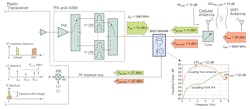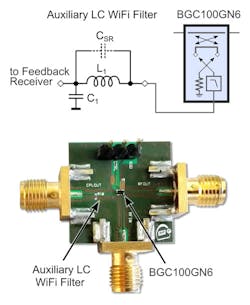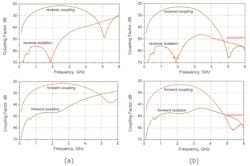Switchable Directional Coupler IC Lends a Hand to RF Front Ends
Download this article in PDF format.
Microwaves & RF would also like to acknowledge co-authors Gilbert Lin and Michael Wilhelm.
A directional coupler in cellular RF front ends is located between the power-amplifier/antenna-switch module and the antenna tuner. It’s used as part of the power control and antenna tuning loops.
1. A switchable directional coupler is located in the RF front end of handheld cellular devices.
Infineon’s BGC100GN6 integrated circuit (IC) contains a directional coupler, a direction switch for selecting the coupled or isolated port, and a filter for 5-GHz ISM blockers suppression (Fig. 1). The feedback receiver (FR) sequentially receives forward- and reverse-coupled signals by changing the position of the switch. There are several benefits to integrating the coupling, switching, and filtering functions on a single die:
- It requires only one RF feedback line from the switchable coupler IC to the FR. Since the RF feedback line must be fully isolated from the main RF path to achieve high directivity, having only one feedback line reduces the complexity and cost of the main phone board.
- The inactive coupled branch of the coupler is terminated internally via a switch by an accurate 50-Ω resistor. This allows over 20 dB of directivity to be achieved independently of the impedance of the RF feedback path.
- A filter for 5-GHz Wi-Fi signal suppression prevents the FR from mixing down the Wi-Fi blockers and distorting the cellular feedback signal. An integrated Wi-Fi filter eliminates the need (or significantly relaxes the requirements) for a discrete lowpass filter in the coupled RF feedback path.
Addressing Coexistence Challenges
Modern handheld devices incorporate multiple radio technologies, including cellular and Wi-Fi radios. Cellular and Wi-Fi transceivers operate simultaneously and independently from each other and may interfere at the RF level.
Even though the cellular and Wi-Fi antennas are physically located at opposite sides of the handheld device, finite RF isolation results in unwanted coupling of the Wi-Fi signal into the main cellular path, with further coupling into an RF feedback path via a coupler IC. As a result, an RF feedback signal applied to a FR will contain cellular and Wi-Fi spectral components (Fig. 1, again).
An FR is a zero-IF downconversion mixer driven by a nearly rectangular local-oscillator (LO) signal with a third harmonic that’s 10 dB below the main tone. If the third harmonic happens to overlap with a Wi-Fi band, then both the Wi-Fi and cellular bands will be downconverted to the same intermediate frequency (IF).
Antenna Tuning Scenario
Assume the cellular radio is transmitting a B2 signal at a frequency (fB2) of 1880 MHz. Furthermore, the RF feedback loop is operating in antenna tuning mode. The switchable coupler is configured to sense an RF signal reflected from the cellular antenna. Assume the forward cellular power (PB2) is +10 dBm and the return loss from the antenna (RLANT) is 15 dB. The power reflected back from the antenna is:
PB2 - RLANT = −5 dBm
This power couples into the FR via a coupler with a coupling factor (CPLB2) of 22 dB at 1880 MHz, resulting in a cellular feedback power level of:
- PFR = PB2 − RLANT − CPLB2 = −27 dBm
While the cellular radio operates in B2, a Wi-Fi signal at 5,640 MHz (fWiFi) is transmitted at a power level of +20 dBm (PWiFi). The isolation between the Wi-Fi and cellular antennas at 5,640 MHz (ISOCELL-WiFi) is 15 dB. The power that couples into the cellular antenna is:
PWiFi - ISOCELL-WiFi = +5 dBm
The signal further couples into the RF feedback loop via the coupler. If the switchable coupler has no Wi-Fi blocking filter (standard coupler), the coupling factor at 5,640 MHz (CPLWiFi) is 22 dB, resulting in Wi-Fi power at the input of the FR equal to:
- PFR = PWiFi − ISOCELL-WiFi - CPLWiFi = −17 dBm
Since fWiFi = 3 × fB2, both the cellular and Wi-Fi bands are downconverted by the FR and fall into the same IF (Fig. 1, again). Given that the relative power of the third harmonic of the LO signal (PLO_H3) is equal to −10 dBc, the cellular-to-Wi-Fi margin can be calculated as:
ΔPCELL-WiFi = PB2.CPL − PWiFi.CPL − PLO_H3 = 0 dB
Such a margin is obviously not acceptable for proper antenna tuning closed-loop control. Thus, the need arises for additional lowpass filtering in the coupled path. In some cases, it’s recommended to insert a discrete passive lowpass filter into the RF feedback path to suppress the unwanted Wi-Fi interference. However, this increases the phone bill of materials (BOM) and board complexity.
The BGC100GN6 coupler IC addresses the issue by using a monolithically integrated Wi-Fi filter in the coupled path. Due to the filter, the coupling factor at Wi-Fi frequencies (CPLWiFi) is 32 dB, which is at least 10 dB better than standard coupler ICs. Hence, the cellular-to-Wi-Fi margin can be increased by 10 dB without any discrete filter in the coupled path. The table denotes two different RF feedback paths.
Improving Cellular-to-Wi-Fi Margin
For most front ends, the power margin achieved with the BGC100GN6 coupler IC is sufficient. The margin improves automatically with an increase in cellular power or reflection from antenna. Among the degrees of freedom for further improvement of cellular-to-Wi-Fi margins at the application level are:
- Increasing isolation between the Wi-Fi and cellular antennas (ISOCELL-WiFi), achieved by physical separation and proper orientation of antennas.
- Addition of a discrete lowpass filter into the coupled RF feedback path for further suppression of Wi-Fi blockers.
The former may be required for high-end RF front ends to achieve the best sensitivity of power control and antenna tuning loops. Since the BGC100GN6 already offers 30 dB of isolation within frequencies from 4.9 to 5.9 GHz, there’s no need for a high-order ceramic filter. A simple LC lowpass filter, implemented with two low-cost surface-mount-device (SMD) components, would provide a total isolation of 50 dB or higher.
The filter could consist of a series inductor followed by a shunt capacitor. Self-resonance of the inductor caused by an inter-winding parasitic capacitance (CSR) improves isolation at Wi-Fi frequencies and should be set between 6 and 7 GHz.
2. This evaluation board contains the BGC100GN6 coupler with an auxiliary LC Wi-Fi filter.
An evaluation board with the BGC100GN6 and a discrete Wi-Fi filter are depicted in Figure 2. The filter, which is located 4 mm away from the coupler IC to avoid any parasitic EMI coupling from the main path into the filter output, consists of a low-cost Murata LQG15HS4N3S02 inductor and a 1-pF capacitor. The inductor reaches self-resonance at 6.7 GHz.
Figure 3 shows the frequency response of the circuit. Fig. 3a illustrates the intrinsic BGC100GN6 response with 30 dB of isolation at Wi-Fi frequencies. Utilizing an auxiliary Wi-Fi filter results in more than 48 dB of isolation from 4.9 to 5.9 GHz (Fig. 3b). This is at least 18 dB higher when compared with just the BGC100GN6 IC. In essence, the cellular-to-Wi-Fi margin improves by 18 dB, reaching 28 dB for the worst-case antenna tuning scenario.
3. Shown is the measured response of the BGC100GN6 coupler IC without (a) and with (b) a discrete LC lowpass filter in the coupled path.
Conclusion
Infineon's BGC100GN6 switchable wideband directional coupler IC with integrated direction switch and Wi-Fi lowpass filter is designed and optimized for RF front ends in cellular handheld devices. With an auxiliary discrete lowpass filter, the BGC100GN6 coupler IC provides a signal-to-distortion ratio suitable for the most demanding high-end systems.





